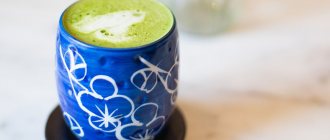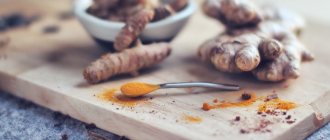Powdered matcha tea is an important part of Japanese national cuisine. The classic way to consume matcha is by brewing tea.
In addition, matcha powder is added to Japanese national sweets (wagashi, dango, mochi, candies, chocolate, desserts, biscuits, cheesecakes, puddings, mousses, cocktails), dough (for coloring dough for noodles, baked goods, batter), and ice cream.
Also used for making drinks (hot and cold), fruit cocktails.
In addition to the homeland of China, Japan, matcha tea was appreciated for its unique properties in the countries of Southeast Asia.
Matcha has become a recognized favorite among tea lovers and connoisseurs. And in recent decades, the most famous drink in the world with such tea has become Matcha latte.
The matcha itself has a rather specific taste. That's why matcha with added milk has become more popular: milk reduces bitterness and masks the umami taste, which is unusual for everyone.
A drink that reveals itself in a new way
Matya latte is a drink based on a special type of tea, and latte means that it is prepared with foamed milk. If desired, sweeteners, nut powder and other additives are added to the cup.
Matcha is a Japanese green tea. Grind into a fine-grained light green powder. Initially, it was produced in China using a special technology - the plants had to grow without direct sunlight. The collected leaves were dried in the shade and ground on stone millstones to a powder. And in 1191, matcha began its march across Japan. At first, the drink was made without additives, although its natural taste had a characteristic bitterness. Now add milk to neutralize the taste.
The peculiarity of this method of tea production is that the leaves are taken without fermentation, with maximum preservation of the entire vitamin and mineral composition of green plants.
1 cup is enough to cover the daily requirement for:
- potassium;
- calcium;
- magnesium;
- fluorine;
- iodine;
- iron.
Don't underestimate the vitamins and antioxidants found in matcha latte coffee. The calorie content of a cup of drink according to the classic recipe is 150 kcal, but if you take skim milk, then a 200 ml cup will contain only 100 calories. A typical serving of matcha contains 35 mg of caffeine, 6 g of protein, up to 6 g of fat, and carbohydrates will vary depending on the additives.
Other types of tea latte are completely different from Japanese tea powder and should not be confused.
To prepare this tasty and tonic drink, you can take any milk, plant or animal origin: coconut, almond, soy, buckwheat, cow.
Chemical composition
Real matcha tea from Japan contains the following beneficial components:
- complex of vitamins B, A, E, P;
- trace elements: iron, potassium, iodine, magnesium, fluorine, calcium, zinc;
- ascorbic acid;
- antioxidants.
The tea has a sweetish taste with a hint of bitterness. It is recommended to drink it without sugar, honey or other sweeteners. The drink has a thick, rich color (both before and after preparation).
The caffeine content in one cup of the drink is identical to the amount in one cup of brewed coffee.
100 g of the finished drink contains 290 kcal.
Reasons for popularity
At first, matcha was known only to vegetarians. And after Gwyneth Paltrow said that she adores him, he began to conquer the American and then the European market. But the reason for love is that it is invigorating like coffee, and healthy like elite green teas. Plus, preparing it at home is faster than brewed coffee.
Bouquet of tea
Matcha latte tea has a bitter taste, but not like the usual green one. Refreshingly sweet tones with a specific viscousness are added to the main tone.
Lady hand holding a white cup of match Latte , Green Tea, on Wooden Background table.
By adding milk to the drink, you get a more delicate, soft taste with creamy notes. The larger and fattier the additives, the higher the calorie content of the finished cocktail. Therefore, the coffee drink vs matcha is liked by fans of green tea and lovers of cappuccino and latte coffee.
Varieties
There are several different varieties that differ in consistency, shade and aftertaste.
Most common
- Dakota is the lightest version of the product. With a characteristic viscous taste.
- Kama is a darker option. To use it, it is permissible to use a small amount of sweeteners.
- Gotcha is better suited for combination with other drinks than its analogues.
- Morning tea is excellent both for drinking in its pure form and with milk or cream.
The following varieties are also distinguished:
- Ceremonial. The most expensive variation, created from young and tender shoots. It is used in Buddhist temples and elite tea ceremonies.
- Premium. The leaves for this type of product are harvested a little later, so the taste is more bitter than the first option.
- Culinary. To manufacture this type of product, the raw materials collected last are used. Its distinctive feature is its rich, tart flavor, which is perfect for baking, ice cream and cocktails.
Whatever variety you choose, when purchasing, pay attention to the color and cost of the product: the real product has a rich green tint and costs no less than 500 rubles per 100 g.
The benefits and harms of matcha latte coffee
The rich composition of the leaves, the gentle production method, and the powder form are the reason for a wide range of beneficial properties:
- antioxidants allow you to maintain youth and health longer, increase resistance to ultraviolet radiation and other harmful factors;
- strengthens the immune system;
- despite the invigorating effect (it contains caffeine), it has a gentle effect on the nervous system, with a stabilizing effect;
- promotes weight loss by accelerating metabolism and improving the breakdown of fats and carbohydrates, although its calorie content is at the level of compote, cocoa or jelly;
- normalizes basic blood parameters, reduces cholesterol and blood sugar, brings blood pressure back to normal;
- helps remove toxins from the body, including sand from the kidneys, and normalizes intestinal function.
The undoubted advantage is that it is easy to prepare with just a few ingredients. Many lovers of this cocktail prefer to drink every last drop, including the sediment at the bottom of the cup, in order to get all the benefits from it.
Contraindications or harm to whom
Everything has its limitations. So, if you are lactose intolerant, you should choose a lactose-free matcha latte recipe that includes coconut milk.
Those who do not want caffeine should also be careful: children under 12 years of age, pregnant women, people with gastrointestinal problems, diabetics and hypertensive patients. This does not mean a complete contraindication, namely, how many cups per day you can drink.
For people with anemia, strong tea will be harmful, as tannin reduces the absorption of iron.
It is not advisable to drink cappuccino tea on an empty stomach; it causes nausea.
Beneficial features
Above, we talked in detail about the increased content of antioxidants in Matcha and the positive effect that such substances have on the human body. But that is not all.
Other benefits of drinking Matcha tea regularly:
- normalizes metabolism;
- burns calories quickly;
- has an anti-inflammatory effect;
- effectively removes toxins;
- energizes and increases concentration;
- improves mental function;
- stimulates brain function;
- helps relieve stress and nervous tension;
- lowers blood cholesterol;
- prevents the occurrence of diabetes;
- reduces the risk of cardiovascular diseases;
- ensures blood glucose balance;
- strengthens the immune system;
- has a beneficial effect on skin health;
- prevents the occurrence of plaque and caries;
- prolongs youth.
Jade drink is the cornerstone of a healthy lifestyle. Buddhist monks made this discovery many centuries ago. Modern people came to it only today.
Lifehack! Mix Matcha powder with toothpaste and brush your teeth with the same mixture. This procedure heals the oral cavity and freshens breath.
Match la at home and in coffee shops
You can enjoy a cup of an incredibly tasty and tonic drink in many places in large cities. In small towns fashion has not yet reached its apogee. The price for a portion of bliss will be about 300 rubles.
But you can learn how to make a cup of matcha latte at home, because the recipe for making it is simple and straightforward. The main thing to get good tea is a high-quality variety. Ideally, special utensils are also needed, but even with only tea leaves powder, everything can be done.
Mask for the face
The positive effects of different products on the skin do not require additional evidence. Face masks have stood the test of time. They began to be used long before the appearance of expensive cosmetic lines.
The properties of Matcha, which make tea useful for drinking, also have a beneficial effect on the skin. Epigallocatechin gallate (EGCG) reduces inflammation and restores tone. Antioxidants fight acne and improve elasticity.
A mask with green tea powder is easy to prepare at home. With regular use of this folk remedy, your skin will become soft as silk.
Simple 2 ingredient recipe
A mask of Matcha powder and honey is prepared in advance and is perfectly stored in anticipation of future use. The result is amazing! The result is a nourishing and moisturizing face mask that is enough to use once a week.
Ingredients:
- Matcha – 1 teaspoon;
- fresh and natural honey – 3 teaspoons.
Instructions for preparation and application.
- Combine honey and green tea powder in any convenient container. Stir until smooth paste consistency.
- Apply the mask to the skin of your face and neck. Use smooth circular movements.
- Leave the composition for 12-15 minutes. Then remove with a warm, damp cloth.
Rejuvenating recipe
Does not contain anything unnecessary. Only Matcha and clean water. The mask will rejuvenate the skin and reduce swelling.
Ingredients:
- Matcha powder – 1 tablespoon;
- pure water.
How to cook it properly.
- Mix tea and a small amount of water. For cosmetic purposes, a composition having the consistency of a paste is suitable.
- Apply the mask to the skin of your neck and face. Leave for 20 minutes.
- After this time, rinse with warm water. The skin should be blotted with a towel.
- Use moisturizer.
A rejuvenating mask is done once every 2-3 days. The effect will be noticeable after the first session.
Acne recipe
Ingredients:
- Matcha - half a teaspoon;
- turmeric – half a teaspoon;
- honey – 1 tablespoon;
- baking soda – 2 tablespoons;
- apple cider vinegar - a quarter teaspoon;
- lemon juice - a quarter teaspoon.
Mix all ingredients until smooth. Apply the mask to damp skin. One application per week is enough.
What else can you mix with?
Combine with yogurt to create a probiotic-rich product.
A mask with Matcha and olive or coconut oil is suitable for dry skin.
When mixed with apple cider vinegar, it makes an excellent facial toner.
A composition with rice flour will help eliminate age spots.
Lifehack! Tea washes. Brew Matcha. Cool, pour the jade drink into ice molds and put it in the freezer. Every day after waking up, wipe your face with the resulting ice cubes. Such washes are especially useful for oily skin.
Popular matcha latte recipes
How to make matcha latte at home is a question that almost every coffee lover asks. To brew a portion of this tea yourself, you need tea leaves (2 g), slightly standing boiling water (~80°C, 50 ml), boiled milk (150 ml). Add cinnamon, sugar, honey, vanilla as desired. How much tea leaves to take depends on the acceptable amount of bitterness in the bouquet.
Accessories that will not be superfluous
Before preparing a traditional matcha vs latte at home, it is advisable to find special utensils: a bowl (chawan, chawan, katakuchi), a bamboo whisk and a Chasaku spoon. If you make tea at home often, a cappuccino maker will come in handy.
Once you learn how to make matcha at home, you can get by with regular utensils. Just a traditional oriental set will allow you to enjoy not only the taste, but also the entire ceremony in an exotic service, and not just cook.
Classic matcha vs coffee
Add the powder and hot water to the chavan (wide bowl for tea drinking) and whisk the mixture with a whisk or fork until a thick paste is obtained. Additives are added to the resulting substance. Add hot milk and whisk vigorously until the contents of the chawan turn into a stable foam. When deciding how much powder to take, you should base it on your taste preferences. But you need to start getting to know this tea with a standard serving - 2 g.
If coconut milk is used, then the recipe is similar, but the components and quantities are added as needed.
Chocolate cocktail
To make a drink with chocolate chips, grated chocolate is added at the final stage, whipped into foam. Some fans heat the cappuccino to a boil and then whisk it.
How does it affect blood pressure?
People with blood pressure problems are extremely careful when choosing food and drinks. This is a healthy and correct approach. Let's figure out how things are going with Matcha. Let’s understand whether this green tea increases or decreases blood pressure.
Doctors call one of the main causes of high blood pressure a specific kidney secretion - ACE, also known as angiotensin-converting enzyme.
ACE is directly involved in the metabolic processes of the human body. For example, by constricting blood vessels, angiotensin-converting enzyme helps increase blood pressure.
Matcha tea is a natural ACE inhibitor. Simply put, jade drink inhibits angiotensin-converting enzyme, which leads to a reduction in high blood pressure. But that is not all. The green tea in question can be used as a prophylactic to prevent high blood pressure.











